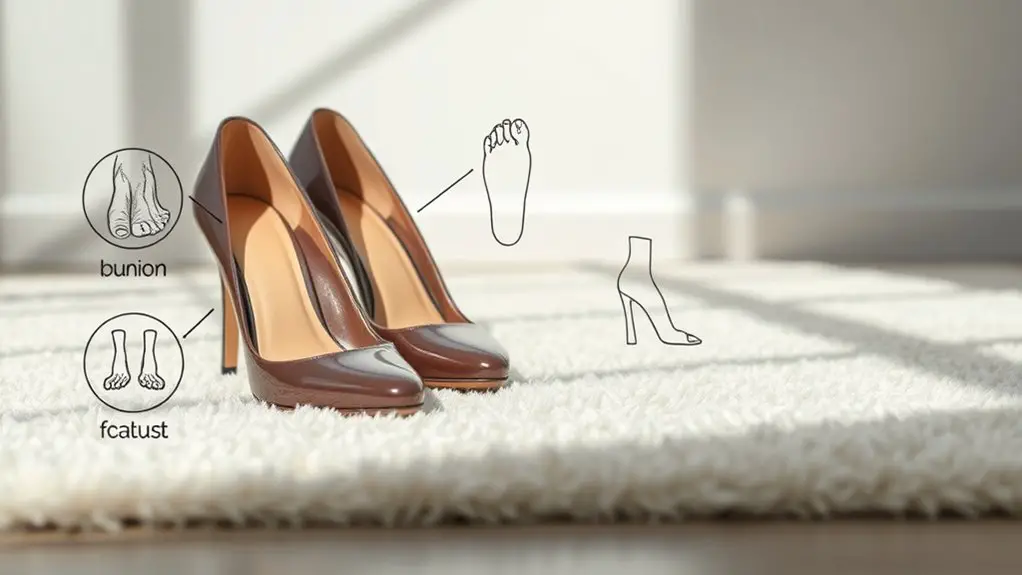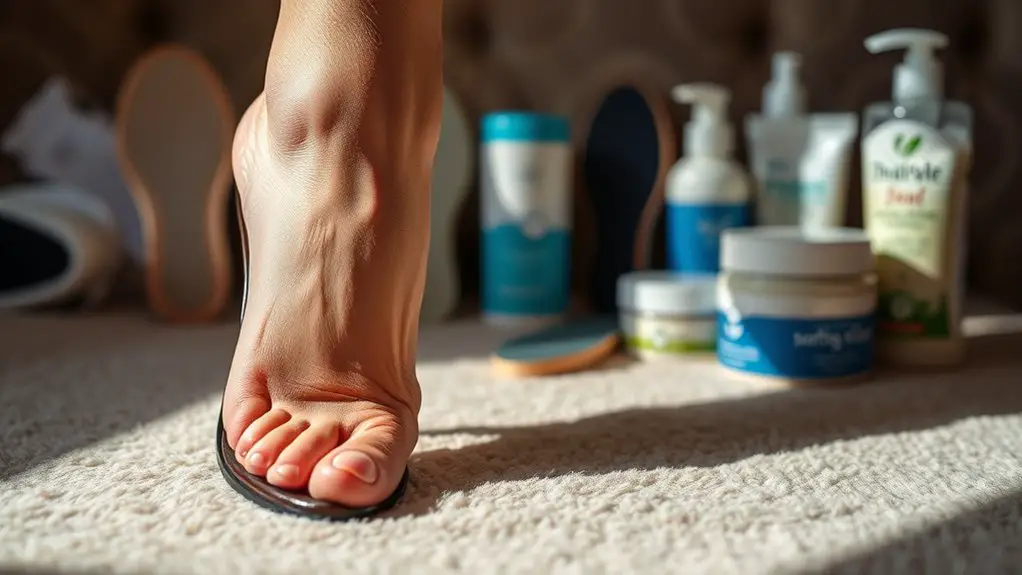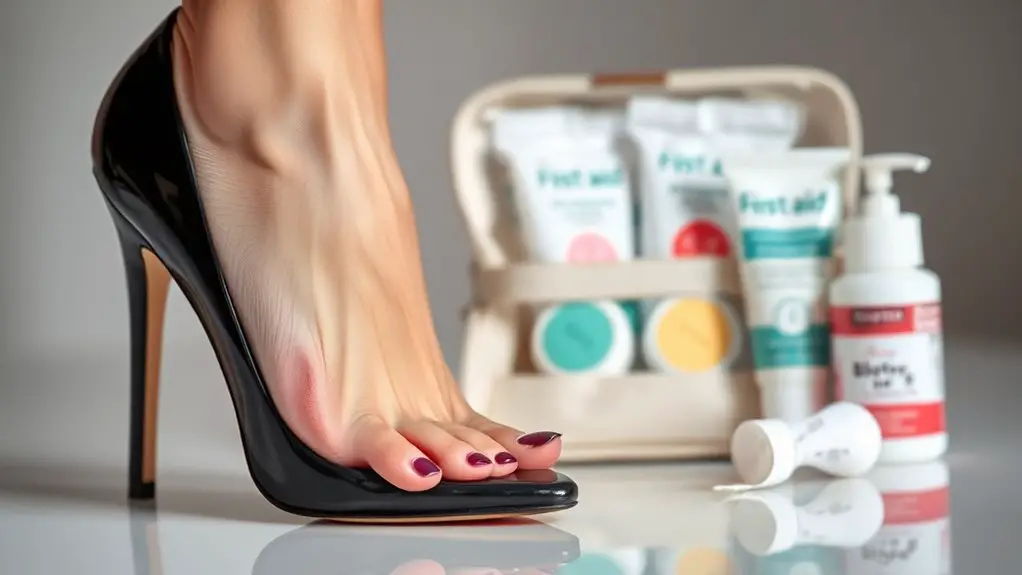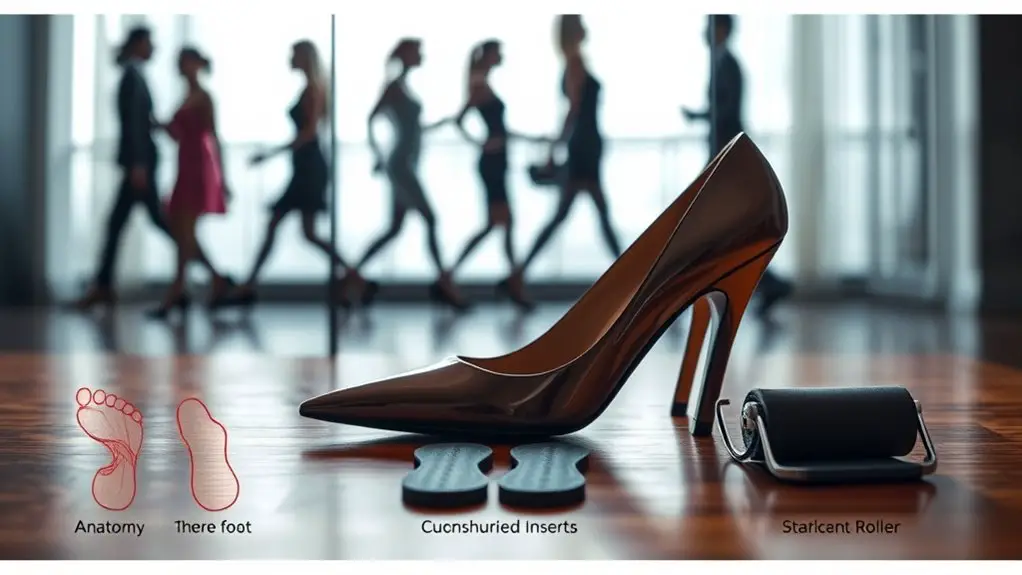Wearing high heels can lead to common foot conditions like bunions, plantar fasciitis, and metatarsalgia. These issues arise from pressure and misalignment caused by narrow toe boxes and elevated heels. To avoid them, choose shoes with a wider fit and lower heels, take breaks from heels, and incorporate foot stretches into your routine. Remember to prioritize comfort and support in your footwear. Keep exploring to uncover more tips on how to protect your feet while enjoying stylish heels.
Understanding High Heel Foot Conditions

High heels can be a stylish choice, but they often lead to various foot conditions that can impact your overall health. Different high heel types, such as stilettos and platforms, exert varying pressure on your foot anatomy. When you wear high heels, your body weight shifts, placing excessive strain on the forefoot and toes. This misalignment can lead to conditions like metatarsalgia, where the ball of your foot becomes painful due to inflammation.
Additionally, wearing heels can shorten the Achilles tendon and tighten the calf muscles, which may result in discomfort and limited mobility over time. The elevated position of the heel alters the natural angle of your foot, increasing the risk of stress fractures and other injuries. Understanding these implications is vital for anyone who frequently wears high heels, as it can help you make informed choices about footwear to mitigate potential health issues.
Bunions: Causes and Prevention
Wearing high heels can contribute to the development of bunions, a common foot deformity characterized by a bony protrusion at the base of the big toe. This condition often arises from improper footwear choices that place excessive pressure on the forefoot. High heels narrow the toe box, forcing the big toe inward and leading to misalignment over time.
To prevent bunions, opt for shoes with a wide toe box and low heels. Prioritize comfort and support in your footwear choices, as they can greatly reduce the risk of bunion formation. If you already have a bunion, consider consulting a healthcare professional for advice on management and treatment options, including bunion surgery if necessary. Early intervention can help alleviate pain and prevent further deformity. Remember, making informed footwear choices is essential in maintaining foot health and preventing bunions from worsening.
Plantar Fasciitis: Symptoms and Remedies

Plantar fasciitis is a common condition that can cause significant discomfort, especially for those who wear high heels regularly. Understanding its causes and recognizing the symptoms is essential for effective management. In this section, you’ll learn about treatment options that can help alleviate pain and promote healing.
Causes of Plantar Fasciitis
While various factors contribute to the development of plantar fasciitis, certain causes are particularly common among individuals who frequently wear high heels. High heels can alter your foot arch, leading to excessive strain on the plantar fascia. This strain can result from the unnatural positioning of your feet, which places more pressure on the heel and arch. Additionally, wearing heels regularly can weaken the muscles that support your foot structure, increasing the risk of injury. Understanding these causes is essential for prevention.
| Cause | Description | Prevention Tips |
|---|---|---|
| Improper Footwear | Shoes lacking support | Choose heels with cushioning |
| High Heel Height | Increased pressure on the foot arch | Opt for lower heels |
| Poor Arch Support | Insufficient support for foot arch | Use orthotic inserts |
| Excessive Standing | Prolonged periods on feet | Take breaks and stretch |
| Weight Gain | Added pressure on the feet | Maintain a healthy weight |
Common Symptoms to Watch
Understanding the potential causes of plantar fasciitis is important, but recognizing the symptoms is equally essential for timely intervention. You might experience significant foot pain, particularly in the heel area, especially after long periods of standing or after getting up in the morning. This discomfort can range from a dull ache to sharp, stabbing sensations. You may also notice that the pain lessens after some movement but returns after prolonged inactivity. Swelling or tenderness around the heel can further indicate the condition. If you find yourself dealing with these symptoms consistently, it’s imperative to take action. Early recognition can prevent worsening of the condition and enable you to maintain a more active lifestyle without persistent foot pain.
Effective Treatment Options
If you’re experiencing persistent heel pain associated with plantar fasciitis, exploring effective treatment options is essential for relief and recovery. Initial management often includes rest, ice application, and stretching exercises to alleviate discomfort. Over-the-counter pain relievers can also be beneficial. If these methods don’t provide relief, consider alternative therapies such as physical therapy, orthotics, or corticosteroid injections. These options can help reduce inflammation and improve foot mechanics. In more severe cases, surgery options may be considered, including plantar fascia release, to relieve tension. It’s vital to consult a healthcare professional to determine the best course of action tailored to your specific condition, ensuring a thorough approach to recovery. Prioritize your foot health to regain comfort and mobility.
Blisters: How to Avoid and Treat Them

Blisters often occur due to friction between your skin and high heel footwear. Understanding their causes, implementing effective prevention techniques, and knowing treatment options can help you manage this common issue. By addressing these factors, you can minimize discomfort and maintain foot health.
Causes of Blisters
While high heels can enhance your appearance, they also contribute to the formation of blisters, which often result from friction and pressure. When you wear ill-fitting shoes or walk in high heels for extended periods, the constant rubbing against your skin can lead to fluid accumulation, forming blisters. Additionally, variations in foot movement can exacerbate friction management issues, increasing the likelihood of blister formation. Moisture from sweat can further weaken the skin, making it more susceptible to injury. Understanding these causes is essential for addressing blisters effectively. By recognizing the role of friction and pressure in blister development, you can better prepare for treatment and recovery, ultimately enabling you to enjoy your high heels with less discomfort.
Prevention Techniques
To prevent blisters when wearing high heels, it’s important to adopt strategies that minimize friction and pressure on your feet. First, choose high-quality footwear materials that provide adequate cushioning and breathability. Look for options made from soft leather or fabrics that mold to your foot shape, reducing irritation. Additionally, consider the heel height; lower heels typically distribute weight more evenly and decrease the chance of blisters. When possible, opt for styles with a wider toe box to alleviate pressure points. Wearing moisture-wicking socks or using blister prevention pads can also help. Finally, gradually break in new shoes by wearing them for short periods, allowing your feet to adjust without suffering damage.
Treatment Options
If you find yourself dealing with blisters from high heels, it’s crucial to address them promptly to prevent infection and further discomfort. Start by cleaning the area with mild soap and water, then apply an antiseptic. For pain relief, consider over-the-counter medications. You can use blister pads or bandages to protect the area and promote healing. When it comes to treatment methods, draining the blister can be effective, but be certain you do so with sterile equipment to avoid complications. Alternative therapies like tea tree oil and aloe vera may also provide soothing relief. Remember to avoid wearing the offending shoes until your blisters heal completely, as continued friction can exacerbate the problem.
Corns and Calluses: What You Need to Know
Corns and calluses are common foot conditions characterized by thickened skin that develops in response to friction and pressure, often exacerbated by high heels. You might notice corns forming on your toes, which can be categorized into hard and soft corn types. Hard corns typically develop on the tops and sides of toes, while soft corns occur between them, often accompanied by moisture.
To prevent these conditions, opt for well-fitting shoes with adequate cushioning. If you already have corns or calluses, treatment options include using over-the-counter pads to relieve pressure or applying moisturizers to soften the skin. In more severe cases, consult a podiatrist for professional removal. Regular foot care and choosing the right footwear can help you avoid painful corns and calluses, ensuring your feet remain healthy and comfortable despite your high heel preferences.
Metatarsalgia: Recognizing and Managing Pain
How can you tell if you’re experiencing metatarsalgia? This condition often manifests as pain or discomfort in the ball of your foot. Common metatarsalgia symptoms include:
- Sharp, aching, or burning pain in the forefoot.
- Increased pain when standing, walking, or wearing high heels.
- Swelling or inflammation in the affected area.
- A feeling of having a pebble in your shoe.
To address metatarsalgia, consider these metatarsalgia treatment options. First, switch to shoes with a wider toe box and adequate cushioning. Second, use orthotic inserts to provide additional support. Third, apply ice to reduce inflammation after activity. Finally, engage in specific stretching exercises to alleviate tension in the foot muscles. By recognizing these symptoms and proactively managing your footwear choices and foot care, you can greatly reduce the risk of developing metatarsalgia.
Achilles Tendonitis: Prevention Strategies
Achilles tendonitis is a common condition that can lead to considerable discomfort and mobility issues, particularly for those who frequently wear high heels. To prevent this condition, it’s essential to incorporate Achilles stretches into your daily routine. Stretching helps maintain flexibility and reduce strain on the tendon. Aim for gentle stretches before and after wearing heels, focusing on calf muscles and the Achilles tendon itself.
Additionally, consider using heel cushions in your high heels. These can provide extra support and reduce the impact on your Achilles tendon, minimizing the risk of irritation and injury. When selecting heels, opt for styles with lower heels and adequate arch support to further decrease strain.
Finally, try to alternate between high heels and more supportive footwear to give your feet and tendons a rest. By implementing these strategies, you can greatly reduce your risk of developing Achilles tendonitis.
Nerve Compression Syndromes: Understanding the Risks
While wearing high heels can enhance your appearance, it also increases the risk of nerve compression syndromes in the feet. Nerve entrapment occurs when nerves are compressed due to the restrictive nature of high-heeled footwear. This can lead to pain, tingling, or numbness. To mitigate these risks, consider the following:
Wearing high heels may elevate your style, but it can also lead to nerve compression and discomfort in your feet.
- Footwear Selection: Choose shoes with a wider toe box to reduce pressure on nerves.
- Heel Height: Opt for lower heels to minimize strain on your feet.
- Sole Padding: Use shoes with cushioned insoles to absorb shock and lessen nerve compression.
- Breaks: Take regular breaks from high heels to relieve pressure and improve circulation.
Choosing the Right High Heels for Comfort and Health
When selecting high heels, what factors should you consider to guarantee both comfort and health? Prioritize heel height; lower heels often reduce strain on your feet. Consider material choice as well; breathable fabrics can improve comfort. Assess the toe box: a wider fit accommodates your toes, preventing discomfort.
Here’s a quick guide to help you make informed decisions:
| Factor | Recommendation |
|---|---|
| Heel Height | Opt for 2-3 inches for comfort |
| Cushioning Options | Look for padded insoles |
| Strap Design | Choose adjustable straps for fit |
Additionally, evaluate your foot arch and select styles that provide adequate support. Seasonal styles may influence color selection, but prioritize fitting tips and brand comparisons to guarantee you’re choosing wisely. Balancing aesthetics with health is essential for long-term comfort.
Frequently Asked Questions
Can High Heels Cause Long-Term Foot Damage?
Yes, wearing high heels can lead to long-term effects, including chronic pain. Prolonged use may cause structural changes in your feet, leading to issues like bunions, plantar fasciitis, and other painful conditions that persist over time.
Are Certain Heel Heights Safer Than Others?
Certain heel heights can indeed impact safety considerations. Lower heels typically offer better stability and reduce strain on your feet, while higher heels can increase the risk of injury and long-term damage. Balance is essential.
How Often Should I Give My Feet a Break From Heels?
You should give your feet a break from heels every few hours, allowing for regular foot rest. Heel break frequency is essential to reduce strain, prevent discomfort, and maintain overall foot health effectively.
Are There Specific Exercises to Strengthen Feet for High Heels?
Yes, specific exercises can enhance foot strengthening and heel flexibility. Try calf raises, toe curls, and ankle rotations. Consistent practice helps support your feet, reducing discomfort when wearing high heels and improving overall foot health.
Can I Wear High Heels if I Have Existing Foot Conditions?
If your feet are a delicate garden, high heels can be weeds. You can wear them, but consider alternative footwear for foot health. Prioritize comfort and consult a professional to avoid exacerbating existing conditions.



